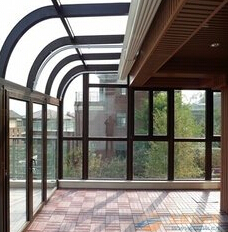
The building doors and windows is part of the building periphery structure. It is the most sensitive part of the building heat exchange. And its energy consumption per unit area is five to six times than that of the wall body. The heat loss of doors and windows accounts for more than 40% of the whole building. There are three ways or factors for the heat loss of doors and windows outside buildings. First, the heat conduction of aluminum alloy extrusions. Second, the radiation heat of glass. Third, the air convection heat through doors and windows gaps. Therefore, producing aluminum alloy doors and windows with heat preservation and heat insulation need to be considered from three aspects as follows.
1. Aluminum alloy profiles
Aluminum alloy materials are good heat conductors whose thermal conductivity is mostly quite high. To make glass with heat preservation and heat insulation, it is necessary to choose profiles which are processed by heat insulation in order to achieve the purpose of heat preservation and heat insulation.
2. Glass
The doors and windows with heat preservation and heat insulation need to adopt hollow glass, because the cavity between the hollow glass is filled with dry and still air. It largely reduces the thermal conductivity. The hollow glass has excellent heat insulation, sound insulation and resistance to frost condensation, moisture condensation. The commonly used hollow glass thickness is five to six mm, and the common cavity thickness is nine to twelve mm.
3. Sealing materials
It is appropriate to choose weather-proof rubber for the doors and windows with heat preservation and heat insulation. It is advisable to choose good ozone corrosion resistance and anti-ultraviolet ageing neoprene products. The overlap opening part of doors and windows need to set up more than three sealing strips.